Let’s face it, selling a new product on Amazon is tough, especially for beginners.
With over 2 million Amazon sellers in 2021, it is not easy to survive in this competitive marketplace without properly understanding how to rank products.
The good new is that not everyone has the expertise to create a full Amazon product launch, from listing creation, promotion via Amazon PPC campaigns, and generate sales.
But once you understand this, you’ll be able to generate sales, get the money flowing, and scale your ecommerce business quickly.
A successful Amazon product launch involves more than just creating your amazon listing and hoping to get your first few sales. You also have to deal with profitable product research, Amazon listing optimization, specific keyword research, and most importantly, ranking your product on the search.
So how do you ensure a successful product launch? What are the things you have to consider before launching a new product? Is there a specific launch strategy you need to follow during the launch phase?
In this article, I’ll talk about how to launch a product on amazon, what is the best product launch strategy, how to build sales velocity, how to do listing optimization, and much more.
My goal is to make you more confident in your Amazon product launch so you won’t lose money.
Let’s jump right in!
Launching A New Product On Amazon: 8 Simple Steps
When preparing for an Amazon product launch, having a strategy and checklist matters.
Following the best practices will ensure that your product launches will be successful.
To help you out, here are 8 simple tips on how to launch your first product on Amazon:
1. Targeting Low Hanging Fruit Keywords
Instead of targeting general keywords that are difficult to rank, it’s better to find low-hanging keywords.
Low-hanging fruit keywords are KW phrases that don’t have a massive search volume.
However, they are pretty easy to rank. Also, the competition around them is not as high.
By having great ranking in lots of low-hanging KWs, their combined external traffic could match the significant KWs in your niche.
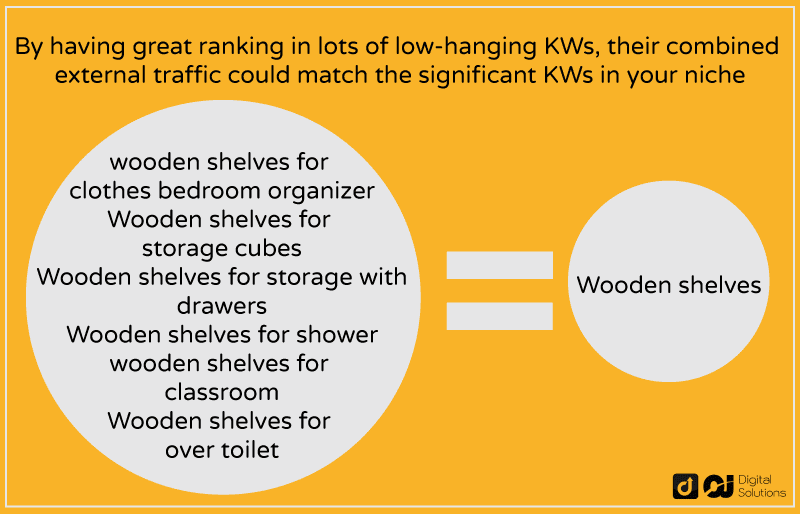
But you have to be creative when doing keyword research.
The specific keywords you are looking for don’t have lots of monthly searches individually. But when combined, they can provide decent external traffic to your listings.
So how do you find low-hanging fruit KWs that you can rank high? Let me show you.
How to find low-hanging fruit keywords
In this example, we’ll use the software called Helium10. It’s an all-in-one tool for keyword research, product research, listing optimization, Amazon PPC campaign, etc.
First, go to Amazon.com, enter a keyword search, and look for the top organic results. List down 5-10 of your top competitors and copy their ASINs.
Let us use “dog teether” as an example product.
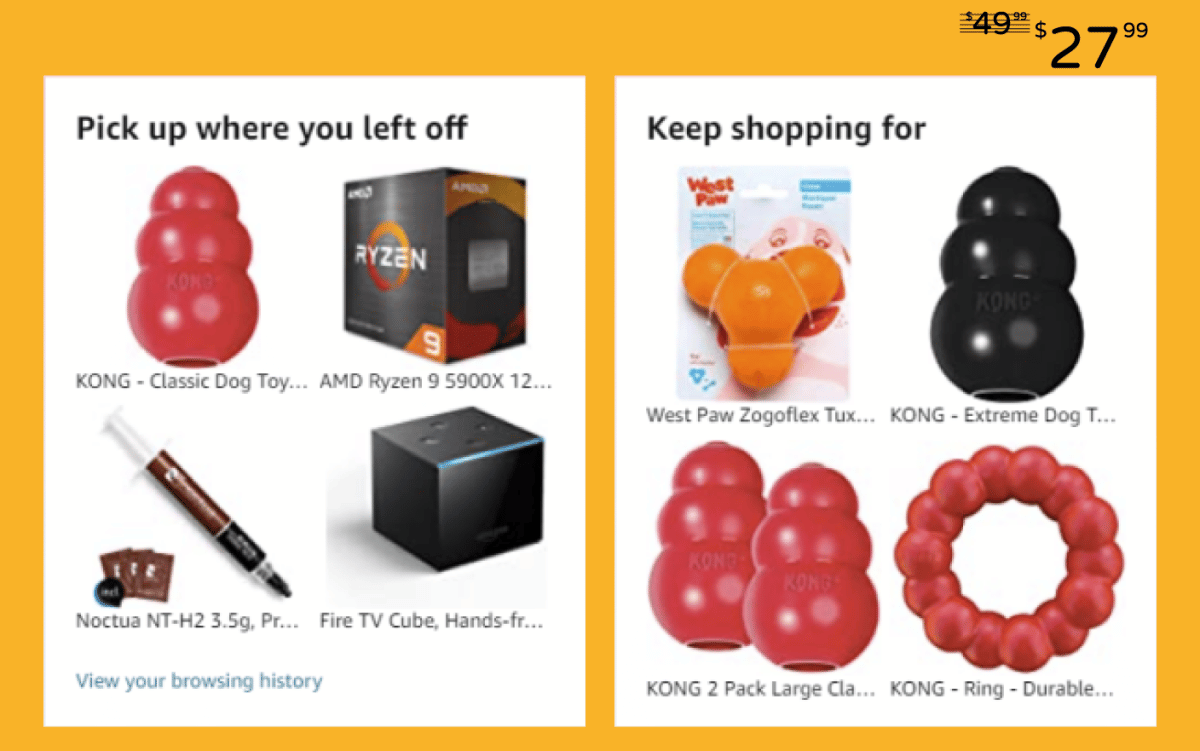
Once you have copied the ASIN of your top 5-10 competitors, go to Helium10 and log in to your account.
Go to the Cerebro Tool and enter up to 10 product ASINs from your top competitors. We will use this tool to find keywords that we can use for both Amazon advertising and organic ranking.
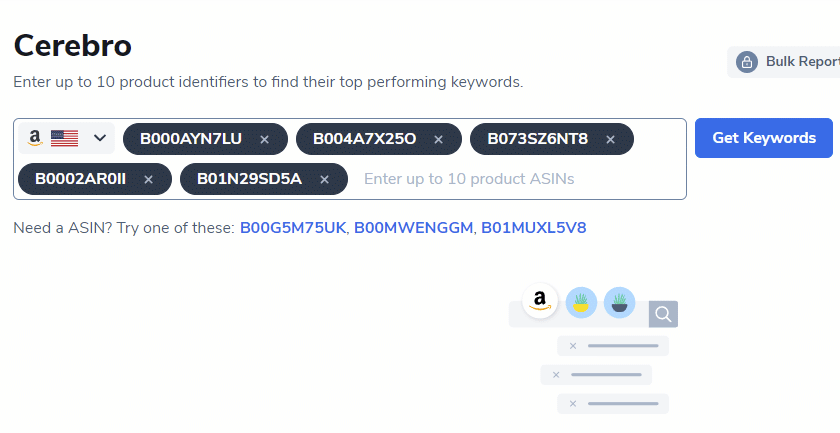
Once you have generated a list of keywords, click Export Data to download your whole keyword list.
We want to find keywords with less than 500 search volumes, above 5000 Cerebro IQ Score, and less than 100 competing products.
These criteria will help you discover keywords that have low competition but decent traffic.
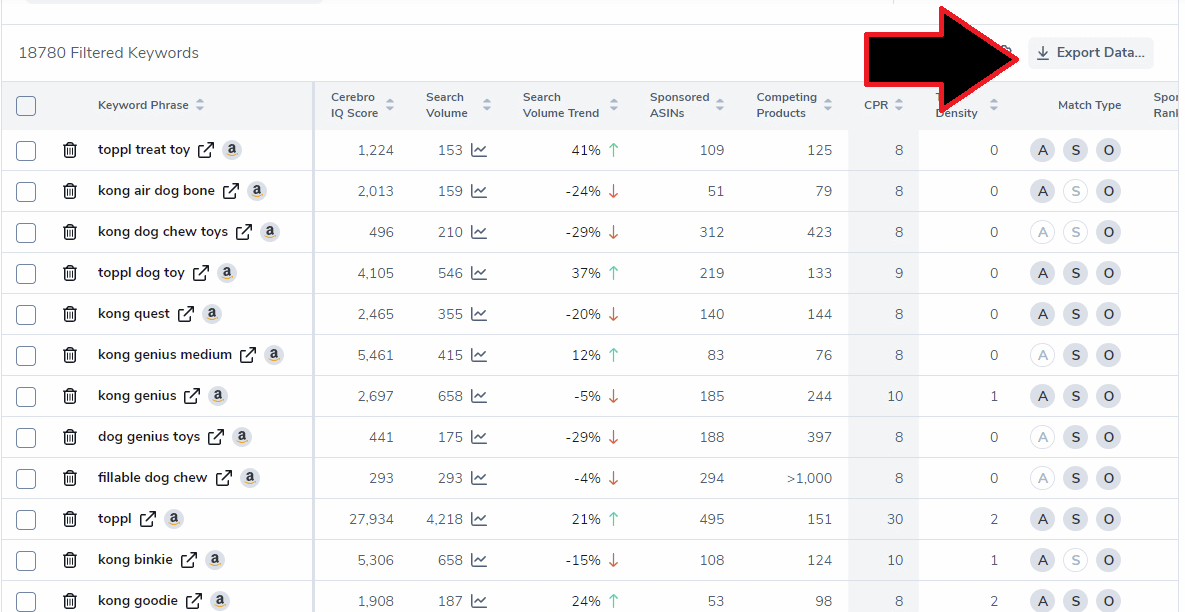
Once downloaded, remove all the columns you don’t need from the excel sheet. Arrange the keywords that you have by volume. Finally, group the related keywords.
2. Optimizing Your Product Listing
The keywords you got from Cerebro will be important in optimizing your product listings.
A winning listing must be well-optimized to rank high in the search results and reach more potential customers. And to achieve that, you must follow Amazon’s copywriting guidelines.
Make sure to sprinkle your keywords and integrate them on your products’ title, content, and bullet points. Use high-quality images as well.
If you are not good with words, hiring a professional Amazon copywriter can help you create high-quality content.
Amazon customers will look at the title, content, bullet points, and product description. So before a product launch, think of the message you want to convey to Amazon shoppers who might see your listings.
Here are some guidelines from Amazon Seller Central.
- Titles should not exceed 200 characters.
- Add your primary keyword not more than once in your title
- Using promotional phrases such as “quality guaranteed” and promising unlikely claims are not allowed.
- Clickbait words such as “Free” are not allowed.
It will also help to take a look at your competitors’ products. What are their strengths and weaknesses? What do the reviews have to say?
Taking note of these things will help you figure out how to make your product stand out from the rest. Highlight your product’s strengths and how it solves your competitor’s weaknesses.
Social media platforms are another way to get important info that you can use for copywriting and listing optimization. Visit relevant Facebook groups before a product launch to see if people would be interested in trying your product.
Checking out your competition will help you write a well-optimized product listing.
Your competitor’s product will give you more than enough information to get started. You have to adapt quickly to the Amazon marketplace like any online store. Knowing the strengths and weaknesses of your competition is already have the battle.
3. Making Attractive Visuals
It is not enough that you have an excellent copy for your ad.
Images and videos have become the universal language of the modern consumer.
The visuals you present significantly impact your marketing strategy and how customers see your brand.
Over 70% of consumers make purchases based on video and image content.
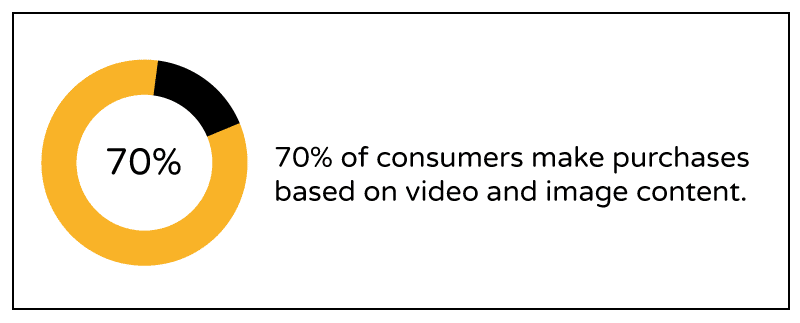
Statistics website Statista also said that consumers aged between 25 to 34 years expected at least 5 photos on any product they purchased online.
They prefer to see detailed images of the products they are interested in before purchasing.
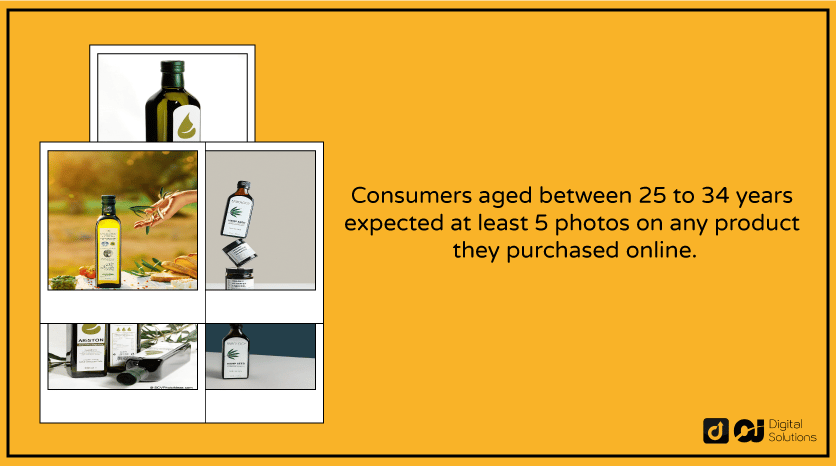
Many young consumers decide their purchases based on visuals and viral videos alone. These days, an excellent ad is sometimes not enough. You need to align your visual marketing with your brand’s message too.
Thus, making visuals that sell is an important element in your launch strategy to attract potential customers.
Images and videos are crucial to the purchasing decisions of today’s consumers. Creating visuals that accurately represent the product is key to improving your conversion rate.
So what are the guidelines for creating visuals that would give you good conversion rates? Here are some of them:
- Images must accurately represent your product (colors, variants, features, etc.)
- Product features must be included
- Photos should be professionally-shot and must have a white background
- The acceptable formats are jpeg, tiff, png, and gif (non-animated)
- Images must be at least 1600px or more prominent on the longer side, so potential buyers can clearly zoom on the product
- The recommended aspect ratio of the images is 1:1 or 2:1
It’s also recommended to have instructional product images or videos to guide people how to use your products.
You can use infographic images to show processes, define features, and even compare the pros and cons of each product.
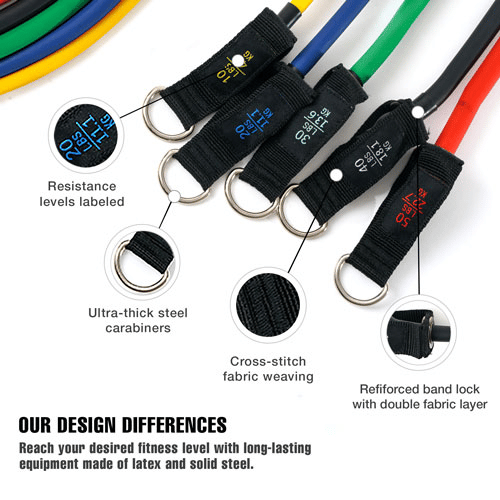
You can also add headlines that represent your brand’s message. A picture paints a thousand words, as they say. But a well-written headline can represent a thousand pictures too!
Building an Amazon A+ Content page is also a perfect way to display visuals for your launch.
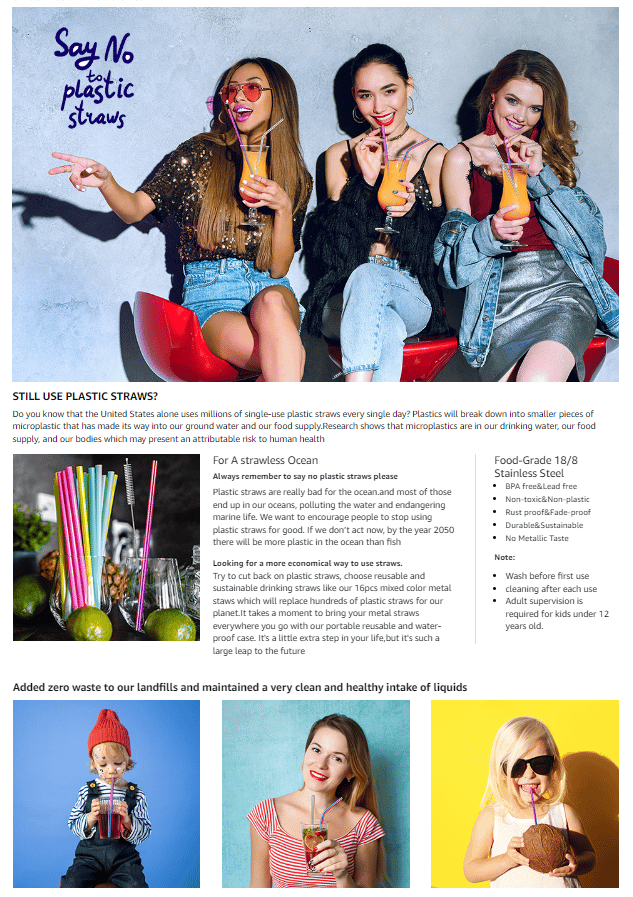
A+ Content allows you to add drag-and-drop widgets that can show your customers high-quality content and images. This could help increase conversion rates.
4. Optimizing The Listing For Maximum Visibility
Listing optimization doesn’t only involve the actual product listing; you have to optimize from the backend as well to make your product listing more relevant and visible.
Before launching a product, you must cover both grounds for maximum visibility.
Relevancy is essential for the visibility of a newly launched product. If Amazon knows what your product is all about, it will also drive traffic from relevant customers.
To do this, go to Amazon Seller Central and click Manage Inventory on the menu bar. This option is found on top of the dashboard. Once you are in, click on all the Active products and choose the product you want to optimize.
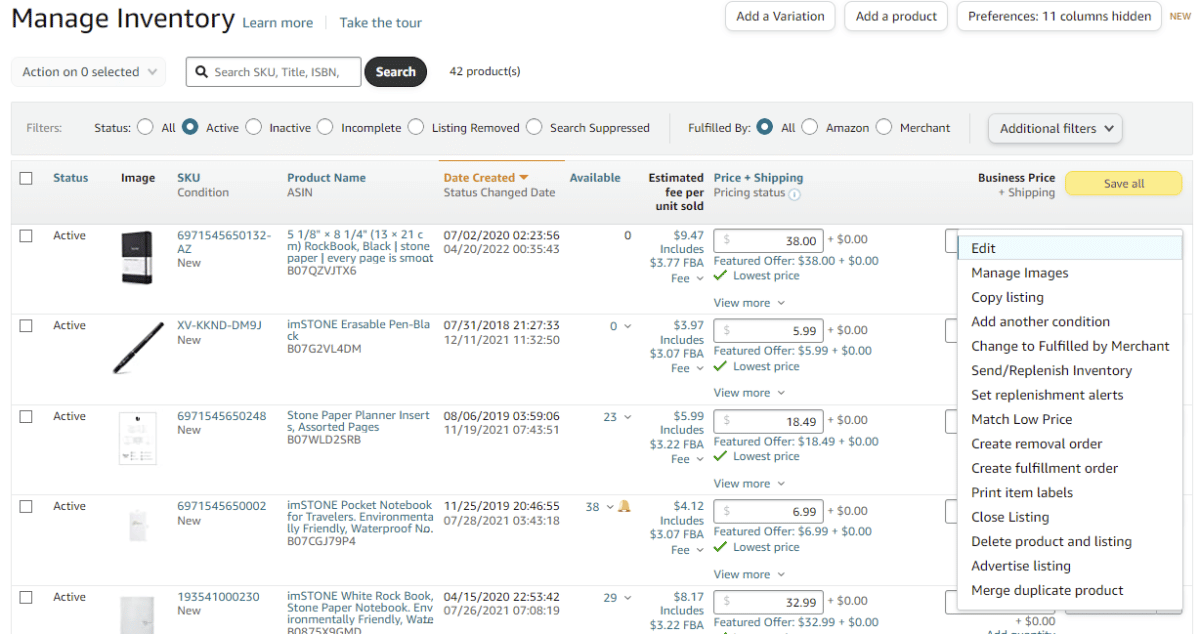
Next, click Edit Listing. As you get redirected to the listing optimization page, fill in the informational fields about your product. This will help you build vital relevancy in the eyes of Amazon.
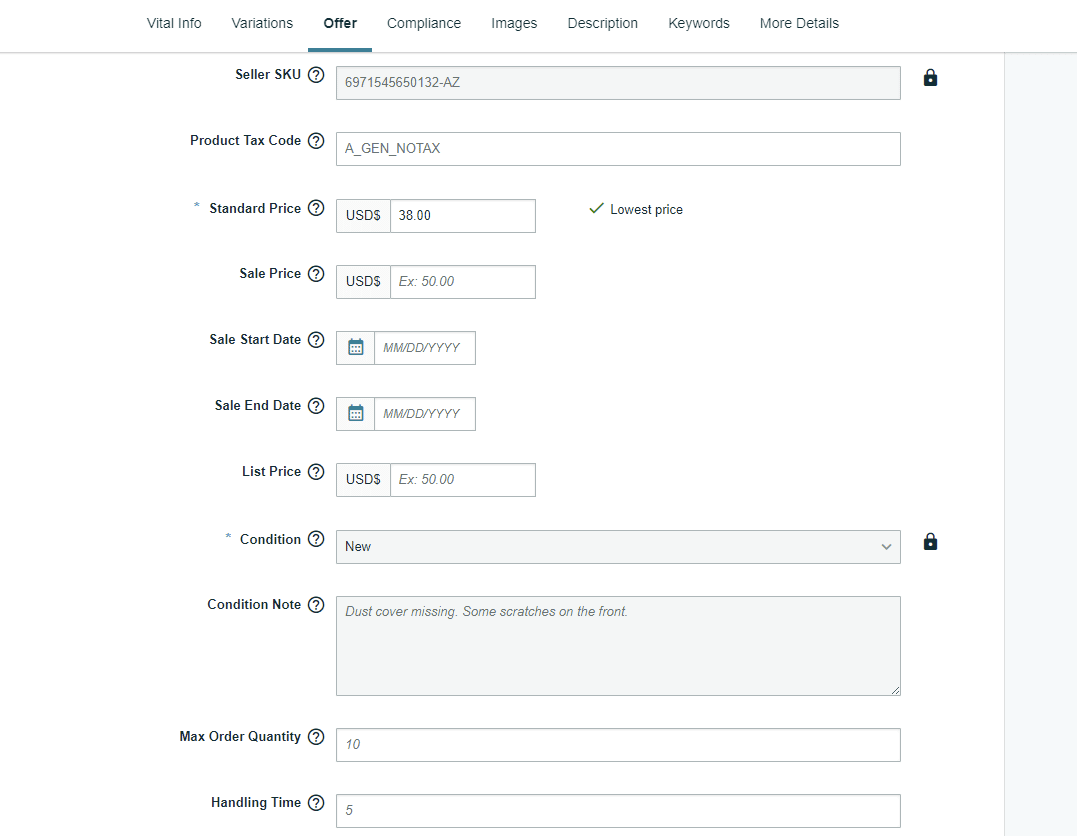
By doing these simple back-end optimization tips, you can raise your relevance in
Amazon’s eyes.
The next thing to do is to use the right keywords on your product listings.
When writing your product pages, aim to add the specific keyword that you are targeting on the following:
- Product title
- Bullet points
- Listing description
- Alt description for the images
- Comparison chart
Make sure to include your keywords in the image names. Renaming images will help index your photos in significant search engines such as Google Images.
So when a customer searches on Google Images, for example, there is a chance your image will show up. Since this image is directly linked to your listing, you can also attract traffic from there.
5. Creating A Marketing Plan For Your Product
Before launching a product on Amazon, you must check your competitors and create a marketing plan based on their performance. Using your competitors as a measuring stick helps you to estimate how much you could earn.
Take the top 3 competitors for your niche and check their Best Seller Ranking (BSR). You can estimate the expected sales volume based on the BSR number.
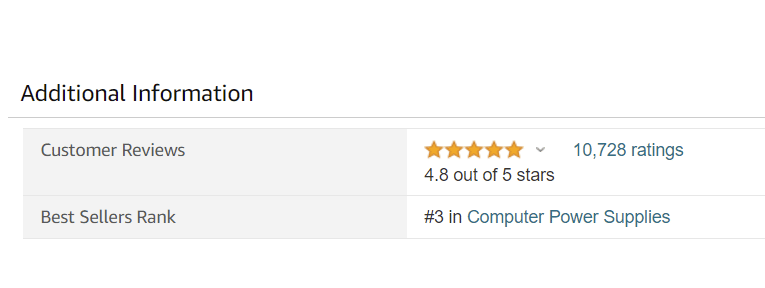
- Products within 8000-1000 BSR = Estimated 4-7 sales per day
- Products within 5000-8000 BSR = Estimated 7-10 sales per day
- Products within 2000-5000 BSR = Estimated 11-20 sales per day
- Products within the top 2000 BSR = 21 or more sales per day
Of course, these numbers are just estimates. This number could fluctuate depending on the season and your target market.
You also have to think about your Amazon PPC campaigns.
On average, the marketing budget to get your product on the first page of Amazon is usually 50 to 60% of your 70-day inventory value.
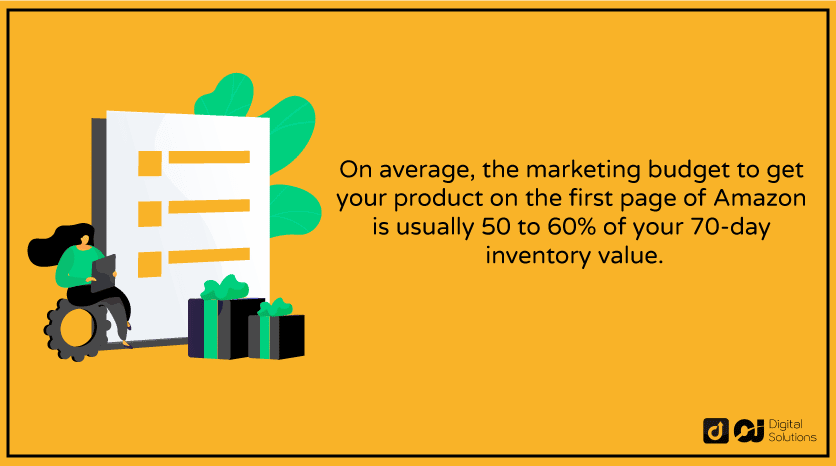
Since you are not selling yet, you can use your competitor’s sales data to estimate how much sales you can make.
Checking for the BSR and reverse-engineering competitor ASIN comes in handy during these situations.
Of course, your newly launched product listing will have zero reviews. So you’ll have to be creative when it comes to marketing your product.
Here are some suggestions that you can use to create buzz around your product launch:
- Visit Facebook Groups and offer a discount code on your products to Amazon product testers.
- Find an influencer who is likely followed by your target market, and ask them to promote your product.
- Attract early customers by giving out a coupon code.
- Offer customers and early adopters your product for a lower price.
- Give free products to influencers so they can promote it to their followers. This is also known as influencer marketing.
- Apply to the Amazon early reviewer program, where you can offer a discount code in exchange for incentivized reviews.
You’ll be surprised how many customers are willing to give you positive reviews for a simple discount code. The more reviews you can generate, the better the social proof, and as such, the higher your Amazon SEO score will be for the A10 Algorithm.
6. Setting Up The Initial PPC Campaigns
Of course, you have no historical sales data before your Amazon product launch.
This means that Amazon can’t give you an organic product ranking yet because Amazon doesn’t know what your product is all about.
So using Amazon Ads (also known as PPC campaigns) is the best way to launch a product on amazon and push your product and appear in the search results. During the first 7-10 days, you have to start strong by building your product’s relevancy.
If a customer searches for a product using a keyword, clicks your product, and ends up buying it, you start to build a relevancy score in Amazon.
The Amazon A10 Algorithm sees sales momentum as a positive sign and can build relevancy off of this information. This is what you want to achieve with your sponsored ads.
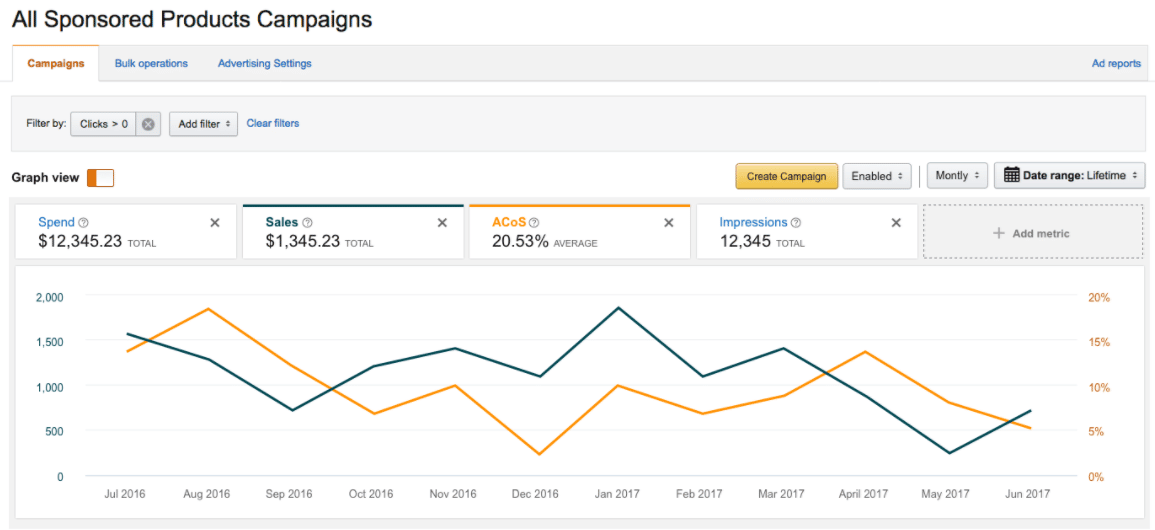
Here are two things that you can do for your initial pay-per-click campaign:
- Manual Exact Campaigns – target one primary keyword per campaign. Suppose the main keyword you want to target is too expensive. You can just target 3 to 4 long-tail keywords instead of that main keyword.
- Manual Exact ASIN Targeting – get the top 20 ASINs related to your niche and try targeting them to drive traffic to your listings.
Your ad copy must be relevant to your target audience in order to get a good click-through rate. The better your CTR is, the higher you’ll appear in the Amazon search results page.
7. A/B Testing Of Price & Visuals
After launching your PPC campaigns, you need to check your click-through rate and conversion rate, and see what you can improve on.
Generating sales is the best way to move up the Amazon search results is to generate sales. But how would you know which among your ads are performing well? Simple. You need to do A/B testing.
A/B Testing means trying out different variations of your ads to find out which one works best. You can change other variables such as:
- Price – reduce the cost for a few days and see if there is an effect on the click-through rate and conversion rates.
- Main Image – customers often react based on the image of a product. See if changing it would affect the CTR.
- Comparison Charts – sometimes, adding comparison charts can increase your conversion rates. With charts, customers can quickly see how your product fares against the competition.
If you want to improve your ranking, you must find the right formula for pricing, main image visuals, and listing content. Seeing the combination that gives you the best CTR and conversion rates can only be done through A/B testing.
8. Understanding A10 & Optimizing PPC To Get Ranked
Amazon 10 Algorithm (formerly A9) is the proprietary search algorithm of Amazon. This algorithm uses different criteria and variables to determine which products rank high in the search results.
Two main factors influence the A10 Algorithm: Sales velocity and keyword optimization. Let’s talk about them briefly below.
Velocity of Sales – Since Amazon is an e-commerce website, it is only fair to assume that it favors sellers who can bring in the most sales to the platform.
Thus, the initial sales generated by your product during launch contribute highly to its ranking.
Keyword Optimization – Optimization of product listings plays a big part in ranking your products. You need to insert your keywords on your title, description, and bullet points.
However, using the correct keyword terms for your PPC campaigns is also critical to your success. Using the right keywords will allow you to bid less while getting enough traffic to generate sales.

Mistakes To Avoid At Amazon New Product Launch
Now that we have discussed the steps for a successful product launch, here are the mistakes that you must avoid to ensure that your launch strategy goes smoothly.
Not Having A Proper Marketing Plan
Your products won’t sell themselves on their own. With millions of other sellers competing in the same space, leaving everything up to chance is not a good way to run a business.
You have to prepare a marketing plan that will cover your launch from start to finish. From the initial promotion to your email newsletter blasts, having a marketing plan serves as a path so you won’t get lost.
The mantra “Build it, and they will come” doesn’t always work, especially in a competitive place like Amazon. You need to have a solid marketing plan if you want to succeed.
A strong Amazon advertising PPC plan combined with a rigid keyword optimization strategy will give you a solid start. New products must be pushed forward by paid marketing and keyword-optimized listings.
Generally, you should think of launching paid campaigns on Amazon itself and off Amazon. When you launch campaigns off Amazon, the link that you advertise will point directly to your product. The most efficient way is to increase Amazon sales with advertisement deep links.
This is done by creating a link that includes the keywords you’re targeting in the URL, and using that URL for promotion, which helps Amazon understand that people typing that keyword are looking for the product you’re advertising.
Ignoring Customer Engagement
Another mistake that you must avoid is ignoring customer engagement. In this day and age, social media news travels so fast. Businesses are affected by how people perceive them online.
So don’t be afraid to create hype around your product. Engage with customers on Facebook, Twitter, and Youtube. See how they feel about your product before launch.
From my experience, you can easily feel if there is a positive engagement towards your products. People on social media comment, like, and share your content more. Pre-launch newsletters get more open rates too.
Positive engagement will give you an idea of whether you will succeed before you even launch a product.
Remove Unsellable Inventory To Keep Your Amazon IPI Score High
Amazon IPI (Inventory Performance Index) measures your inventory performance over a period of time. A high IPI score means that you are efficient — it means your products are selling well.
Amazon uses IPI scores to measure whether products should appear on its front page. Sellers with high IPI often have products that sell well, so they get pushed forward.
To keep your inventory performance index high, remove underperforming products. Focus on items that sell well and use your resources to promote them through advertising.
Expect The Unexpected
Always expect the unexpected. Even if you have already planned everything to the letter, there will always be unforeseen variables that might come your way.
For example, little things such as competitors increasing their keyword bids on PPC can drastically reduce your external traffic. These unforeseen events can affect your launch and result in lower sales.
Always play the “pessimistic” part while staying optimistic during your launch.
Listing Update To Optimize It Further
Don’t rest on your laurels. If you see an opportunity to optimize your listings further, then go for it.
Optimizing your listings and adding the right keywords can boost the organic traffic for your listings. This traffic can easily convert into more customers, which means more initial sales during launch.
See what your competitors are doing and learn from them. If you find something that works, use it to optimize your listings further.
Not Doing Amazon Advertising
Amazon advertising is crucial when launching a new product. Since you are not ranking for any significant keywords yet, you can’t rely on organic ranking to bring home the bacon.
If you are not advertising through Amazon, you are losing the opportunity to push the velocity of your sales upward. You won’t be able to get enough traffic to drive sales. And without sales, the A10 Algorithm will not increase your organic rankings.
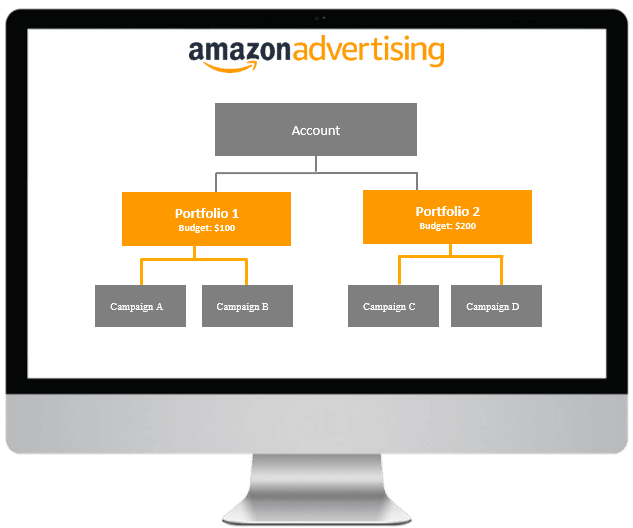
Launch a product with a strong advertising and marketing plan behind you. Without a strong push from advertising, any launch strategy will not be successful.
FAQ – Frequently Asked Questions
How long does it take to launch a product on Amazon?
It depends on how much time you want to spend preparing for the launch.
You have to secure the product source, ship the products to your inventory, prepare your advertising plan, etc. A month of preparation is usually the average to launch a new product.
How much does it cost to launch an Amazon product?
Again, this number will depend on the product that you want to sell. The more expensive the products you want to sell, the higher your initial inventory costs would be.
These are the things you have to keep in mind when you launch a product:
- Product costs
- Inventory storage costs
- Marketing costs (email blasts, discount coupons, vouchers)
- Advertising costs (flyers, pay-per-click ads, etc.)
Plan your budget around these four things, and you can estimate how much it costs to launch a product.
What is a successful product launch?
A successful product launch gives you the following:
- Generate sales velocity
- Creates ample demand
- Gets your product popular
- Improves your organic ranking
The “honeymoon period,” or the first two weeks after the launch, is crucial. You must be able to build enough initial sales during this period to stick your organic rankings on the first page of Amazon.
What’s the best day to launch a product?
Based on our research, Sunday is the best day to launch a product.
On Sundays, people are much more relaxed, and most have nothing else to do. So they are more likely to browse the Amazon app and make a purchase compared to a hectic day such as Monday or Tuesday.
Why do most product launches fail?
My experience tells me that most product launches fail due to a lack of preparation. People think that launching a product is easy. They believe customers will come, and sales will pile up as long as they post a product listing online.
Proper preparation is the key to a successful launch. Cover all the possible problems and prepare for the worst-case scenario. It’s better to prepare too much because it gives you less room for error.
Bottom Line
A successful Amazon product launch strategy is a direct result of your efforts. The more prepared you are, the more likely your launch will be successful.
In conclusion, here are some of the points you need to remember when launching a new product on Amazon:
- Run PPC advertising campaigns
- Target low-hanging keywords
- Optimize your product listings
- Create a marketing plan
- Remove products that don’t sell
- Do A/B Testing on your listings and ad copies to improve CTR and conversion rates.
- Drive traffic through social media channels and email blasts
Hopefully, the information I shared with you today can help propel your business to the top!
Good luck with your product launch — make the proper preparations and set yourself up for success!




